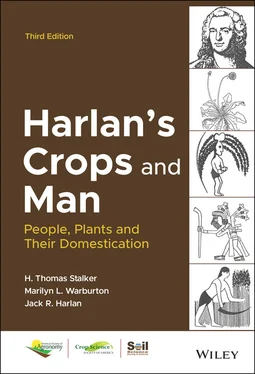1 Cover
2 Title Page
3 Copyright Page
4 Preface
5 1 Prologue Crop Evolution The Hunter‐Gatherer Stereotype What Do Gatherers Eat? Summary Understanding Life Cycles of Plants General Botanical Knowledge Manipulation of Vegatation Food Plants in Ritual and Ceremony On Sharing the Bounty Population Control and the Aged Conclusions References
6 2 Views on Agricultural Origins Agriculture as Divine Gift Domestication for Religious Reasons Domestication by Crowding Agriculture as Discovery Agriculture by Stress Agriculture as an Extension of Gathering Domestication by Perception A No‐Model Model Geography of Plant Domestication An Ecological Approach Conclusions References
7 3 What Is a Crop? Definitions Intermediate States A Short List of Cultivated Plants References
8 4 What Is a Weed? Definitions Intermediate States Crop–Weed Complexes Some Weed Adaptations Weeds and History Conclusions References
9 5 Classification of Cultivated Plants Botanical Descriptions and Names Problems of Formal Taxonomy The Gene Pool System Evolutionary Implications Conclusions References
10 6 The Dynamics of Domestication Domestication of Seed Crops Domestication of Vegetatively Reproduced Crops Conclusions References
11 7 Space, Time, and Variation Kinds of Patterns of Variation Noncentric Crops Diffuse Origins Microcenters Landrace Populations Implications for Plant Breeding Conclusions References
12 8 The Near East Introduction Archaeological Prelude A Note About Dating Archaeological Sites Archaeological Sequence of Village Sites Spread of Agriculture Out of the Nuclear Area Recorded History Conclusions References
13 9 Indigenous African Agriculture Introduction Archaeological Prelude A Savanna Complex Crop Competition and Distribution Recorded History Décrue Agriculture Conclusions References
14 10 The Far East Archaeological Prelude Recorded History Far Eastern Crops Hunter‐Gatherers of Japan Plant Domestication in India References
15 11 The Americas Archaeology The Crops Indigenous Americans as Biochemists Conclusions References
16 12 Epilogue References
17 End User License Agreement
1 Chapter 1 Table 1.1 Diet of the !Kung Bushmen. Table 1.2 Analysis of wild and cultivated wheats. Table 1.3 A short list of genera that include one or more species harvested f...
2 Chapter 2 Table 2.1 Major time periods delineated by years before present (BP).Table 2.2 The world's 30 leading food crops in terms of estimated edible dry ...
3 Chapter 3Table 3‐1 A short list of cultivated plants and their probable origins in the...Table 3.2 A short list of cultivated plants and their probable origins in the...
4 Chapter 4Table 4.1 Definitions of weeds.
5 Chapter 5Table 5.1 Classification of sorghum.
6 Chapter 6Table 6.1 Adaptation syndromes resulting from automatic selection due to plan...Table 6.2 The more important species of Dioscorea used for human food (adapted...
7 Chapter 7Table 7.1 The international centers with major crop genetic resource holdings...Table 7.2 A sample of the major national gene banks in the international syst...
8 Chapter 8Table 8.1 Plant remains from selected early villages. Sources from site repor...
9 Chapter 11Table 11.1 Some early American archaeological sites and associated cultivated...
1 Chapter 1 Figure 1.1 Food‐gathering activities of the Australian Aborigines.
2 Chapter 2Figure 2.1 The eight‐centers of origin, according to N. I. Vavilov.Figure 2.2 Centers and noncenters of agricultural origins: (A1), Near East c...Figure 2.3 Well‐developed temperate prairies and deserts.Figure 2.4 Tropical rainforests, temperate forests, and Mediterranean woodla...Figure 2.5 Tropical savannas and dry forests, and tropical highlands.
3 Chapter 4Figure 4.1 Species adaptation to environmental disturbances.Figure 4.2 The spectrum of sentiment toward plants.
4 Chapter 5Figure 5.1 Schematic diagram of primary gene pool (GP‐1), secondary gene poo...Figure 5.2 Gene pools of Arachis . The cultivated species is an allotetraploi...
5 Chapter 6Figure 6.1 Schematic diagram of differentiation–hybridization cycles dependi...
6 Chapter 7Figure 7.1 Some lesser millets of West Africa. Brachiaria deflexa and Digita ...Figure 7.2 Distribution of major areas of cultivation of yams and African ri...Figure 7.3 Suggested early movements of sorghum. Initial domestication in sh...Figure 7.4 Suggested later movements of sorghum in Africa (from Harlan and S...
7 Chapter 8Figure 8.1 Distribution of known and reasonably certain sites of wild barley...Figure 8.2 Distribution of known and reasonably certain sites of wild einkor...Figure 8.3 Distribution of known and reasonably certain sites of wild emmer....Figure 8.4 Approximate dates of some Neolithic farming settlements.
8 Chapter 9Figure 9.1 Map of Northern African showing sites and regions mentioned in th...Figure 9.2 Known distribution of wild pearl millet ( Pennisetum glaucum subsp...Figure 9.3 Known distribution of wild African rice ( Oryza glaberrima subsp. Figure 9.4 Probable areas of domestication of selected African crops: (1) Ur ...Figure 9.5 Two ships from Queen Hatshepsut’s expedition are being loaded wit...
9 Chapter 10Figure 10.1 Early Neolithic sites in China.Figure 10.2 Sites containing evidence of exploitation of local plant and ani...Figure 10.3 Known distribution of wild and domesticated rice in Asia. The ga...
10 Chapter 11Figure 11.1 Examples of early sites of plant domestication in the Americas....Figure 11.2 Documented sites of teosinte distribution in Central America....Figure 11.3 Examples of regions of domestication of several major world crop...
1 Cover Page
2 Title Page
3 Copyright Page
4 Preface
5 Table of Contents
6 Begin Reading
7 Wiley End User License Agreement
1 iii
2 iv
3 viii
4 ix
5 1
6 2
7 3
8 4
9 5
10 6
11 7
12 8
13 9
14 10
15 11
16 12
17 13
18 14
19 15
20 16
21 17
22 18
23 19
24 20
25 21
26 22
27 23
28 24
29 25
30 26
31 27
32 28
33 29
34 30
35 31
36 32
37 33
38 34
39 35
40 36
41 37
42 38
43 39
44 40
45 41
46 42
47 43
48 44
49 45
50 46
51 47
52 48
53 49
54 50
55 51
56 52
57 53
58 54
59 55
60 56
61 57
62 58
63 59
64 60
65 61
66 62
67 63
68 64
69 65
70 66
71 67
72 68
73 69
74 70
75 71
76 72
77 73
78 74
79 75
80 76
81 77
82 78
83 79
84 80
85 81
86 82
87 83
88 84
89 85
90 86
91 87
92 88
93 89
94 90
95 91
96 92
97 93
98 94
99 95
100 96
101 97
102 98
103 99
104 100
105 101
106 102
107 103
108 104
109 105
110 106
111 107
112 108
113 109
114 110
115 111
116 112
117 113
118 114
119 115
120 116
121 117
122 118
123 119
124 120
125 121
126 122
127 123
128 124
129 125
130 126
131 127
132 128
133 129
134 130
135 131
136 132
137 133
138 134
Читать дальше












